Gregory A. Fournier's Blog, page 14
November 17, 2019
The Elusive Purple Gang--Now Available From Amazon
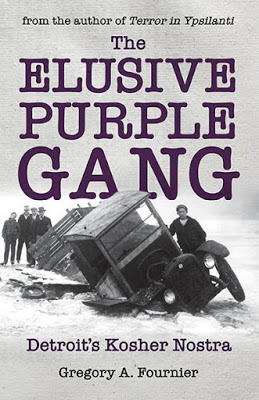
The Elusive Purple Gang: Detroit’s Kosher Nostra is a concise history of one of America’s most notorious and violent Prohibition gangs. The four Burnstein brothers and their associates were the only Jewish gang in the United States to dominate the rackets of a major American city.
From their meteoric rise to the top of Detroit’s underworld to their ultimate demise, The Elusive Purple Gang is an episodic account of the Purple Gang’s corrosive pursuit of power and wealth and their inevitable plunge towards self-destruction.
A quality Wheatmark Inc. paperback edition is now available from Amazon with ebook formats avaliable at the end of November. A digital audiobook is in production and should be available in late December.
2020 marks the one-hundredth anniversary of Prohibition. I hope readers young and old will find The Elusive Purple Gang informative and interesting. As always, Amazon reviews are kindly encouraged. Thank you.
AVAILABLE NOW
Published on November 17, 2019 09:33
November 11, 2019
John Norman Collins's Murder Alibi
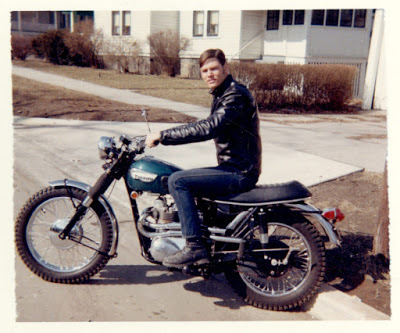 John Norman Collins on Triumph motorcycle he used to pick up Karen Sue Beineman.
John Norman Collins on Triumph motorcycle he used to pick up Karen Sue Beineman.Part three of the Detroit Free Press retrospective article on killer John Norman Collins and the Washtenaw County Murders details two prison letters he wrote to his Canadian cousin John Philip Chapman in 2013. In them, Collins states he is innocent of the Karen Sue Beineman and Alice Kalom murders, and he names the killer.
A footnote to this three-part feature story is that Collins broke his long-standing rule of not responding to media requests and wrote the Free Press last Tuesday asking that they not publish the articles. Then, he proceded to slander me writing I was using him to snare women into my web. Just for the record, I don't have a web.
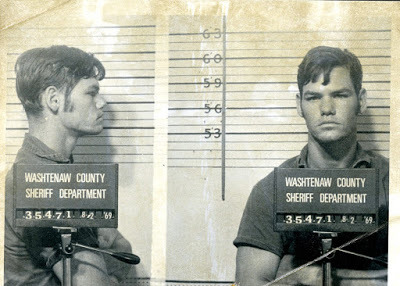 John Norman Collins Mugshot August 2, 1969.Collins throws Eastern Michigan University Roommate Under Prison bus
John Norman Collins Mugshot August 2, 1969.Collins throws Eastern Michigan University Roommate Under Prison bus
Published on November 11, 2019 10:08
John Norman Collins's Bogus Murder Alibi
 John Norman Collins on Triumph motorcycle he used to pick up Karen Sue Beineman.
John Norman Collins on Triumph motorcycle he used to pick up Karen Sue Beineman.Part three of the Detroit Free Press retrospective article on killer John Norman Collins and the Washtenaw County Murders details two prison letters he wrote to his Canadian cousin John Philip Chapman in 2013. In them, Collins states he is innocent of the Karen Sue Beineman and Alice Kalom murders, and he names the killer.
A footnote to this three-part feature story is that Collins broke his long-standing rule of not responding to media requests and wrote the Free Press last Tuesday asking that they not publish the articles. Then, he proceded to slander me writing I was using him to snare women into my web. Just for the record, I don't have a web.
 John Norman Collins Mugshot August 2, 1969.Collins throws Eastern Michigan University Roommate Under Prison bus
John Norman Collins Mugshot August 2, 1969.Collins throws Eastern Michigan University Roommate Under Prison bus
Published on November 11, 2019 10:08
November 10, 2019
The Washtenaw County Murders--1967-1969
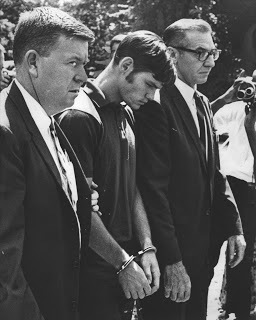 Photo credit: The Detroit Free PressOver a period of three summers, the bodies of seven Michigan young women and a high school student from Oregon visiting in California were found discarded in the countryside. The prime suspect was a handsome, high school sports star from Center Line, Michigan, who began his killing spree at Eastern Michigan University in 1967. Part two of this three part feature recounts the murders.
Photo credit: The Detroit Free PressOver a period of three summers, the bodies of seven Michigan young women and a high school student from Oregon visiting in California were found discarded in the countryside. The prime suspect was a handsome, high school sports star from Center Line, Michigan, who began his killing spree at Eastern Michigan University in 1967. Part two of this three part feature recounts the murders.The Victims
Published on November 10, 2019 09:06
November 8, 2019
Detroit Free Press Delves Into the John Norman Collins Case
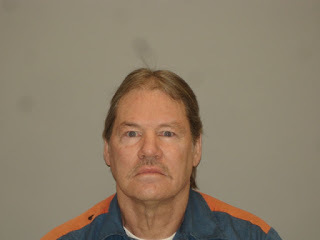 Michigan Department of Corrections mugshot--2014.
Michigan Department of Corrections mugshot--2014.Detroit Free Press investigative reporter Frank Witsil took up the John Norman Collins murder cases and discovered that I have a collection of over twenty prison letters Collins wrote over the years to four different people--all who voluntarily decided to share them with me.
Two of those prison letters were sent to Collins's Canadian cousin John Philip Chapman. What makes those letters different from the others is for the first time Collins puts forth an alibi for the murders of Alice Kalom and Karen Sue Beineman. His motive for doing so will be made quite clear.
Witsil's three-part survey of the Collins case concludes with an exclusive report detailing his alibi which throws his former Eastern Michigan University roommate under the prison bus fifty years after the fact. People who follow this case will be more interested in the state of Collins's mind than any serious criminal revelations. Parts two and three of the Detroit Free Press feature will run in the coming days.
Collins Feature--Part One
Published on November 08, 2019 08:31
October 2, 2019
Detroit Police Pioneer Radio Dispatching During Prohibition
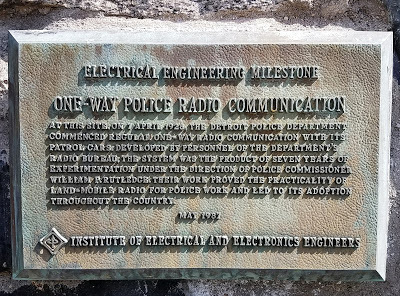
During the lawless period of Prohibition, law enforcement and the underworld took full advantage of the automobile as their mode of transportation. The four-cylinder Ford Model T was inexpensive enough to be widely available to the masses and law enforcement. But other automobile manufacturers were making more expensive sleeker and faster cars giving gangsters the edge. The underworld had a ready source of money where the police had to go through official channels to secure government funding. Car manufacterers like Cadillac, Chrysler, Packard, Chevy, and Dodge outclassed and out-maneuvered the policeman's Tin Lizzy.
It wasn't until December 2, 1927, that Ford Motor Company introduced its V-8 engine making the Model A the car to beat. It left the in-line six-cylinder engines of its competitors in the dust. The Detroit Police were quick to buy thirty Ford Phaetons equipped with a new weapon in their fight against organized crime.
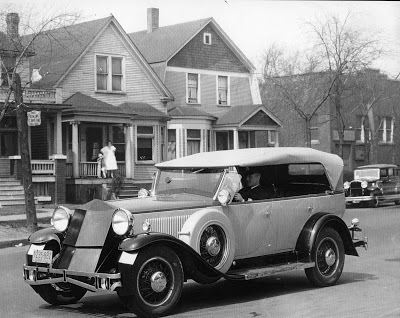 Ford Phaeton, V-8, radio-equipped Detroit police car.
Ford Phaeton, V-8, radio-equipped Detroit police car. Notice the bullet deflector protecting the radiator.
Detroit Police began experimenting with radio-equipped patrol cars in 1921. At first, it was one-way communication that could dispatch cars but not receive signals from patrol cars. Patrolmen had to find a phone booth to report to the station. In those days, the Detroit Police shared a frequency with a commercial radio station and cut into its programming to dispatch patrols.
Seven years later on April 7, 1928, Detroit Police radio operators broadcast throughout the city for the first time on a dedicated frequency from the Belle Isle police precinct. The new radio system reduced police response times and increased arrest rates. It was an instant success, quickly making radio-dispatching standard police practice nationwide.
In 1987, the Institute of Electrical and Electronic Engineers honored the technical achievement of the Detroit Police Department with a plaque on the front of the now deserted Belle Isle precinct station, commemorating the electrical engineering milestone of dedicated police radio communications.
Published on October 02, 2019 08:01
September 25, 2019
Berry Gordy's Lost Portrait
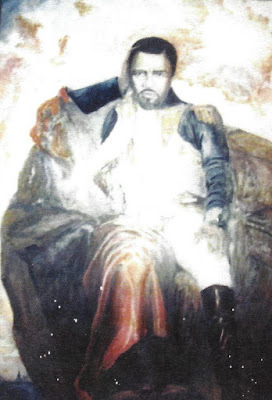 Rare photo of DeVon Cunningham's portrait of Berry Gordy
Rare photo of DeVon Cunningham's portrait of Berry Gordy--washed out from a flashbulb.
Berry Gordy and Motown Records did for popular music what Henry Ford and his company did for the automobile business--they changed American culture. Coincidently as a young man, Gordy worked on Ford's assembly line and learned lessons he would apply to his music empire allowing Motown to crank out an unprecedented number of hits enriching the American songbook--bringing what was once labeled as "race music" into the era of "rhythm & blues." While Henry Ford made automobiles available to the masses, Berry Gordy brought his Motown sound to a national and international audience crossing racial barriers once thought impassible.
In the late 1960s, Anna Gordy Gaye--sister of Berry and wife of Motown performer Marvin Gaye--commissioned Detroit artist DeVon Cunningham to paint a portrait of her mogul brother. The first two attempts with Berry in a shirt and tie were cast aside because Anna felt they didn't capture Berry's "spirit." When Marvin Gaye complained after losing an argument with Gordy about a creative issue, he said, "That man is a fierce warrior." That image resonated with Anna. She showed a portrait of Napoleon to Cunningham which evolved into a portrait of Berry Gordy.
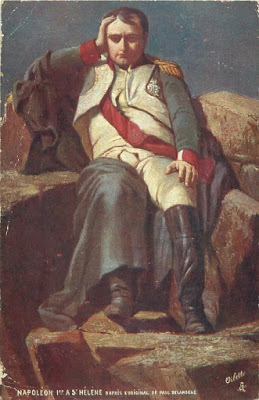 Napoleon Before St. Helene by Paul Delaroche
Napoleon Before St. Helene by Paul DelarocheAnna presented the portrait to her brother on October 4, 1969, at the annual Loucye Gordy Wakefield Scholarship fund raiser, enabling twenty-six inner-city high school graduates to attend college. The fundraiser was held at Gordy's Boston-Edison, tile-roofed Renaissance estate.
Mrs. Gaye maneuvered the guests into a large parlor where the huge painting hung. Artist DeVon Cunningham unveiled the portrait before the assembled guests--including many of Detroit's glitterati. There it was, Berry Gordy with an imperious look of command on his face as a Black Napoleon. Berry took one incredulous look and broke into laughter. Cunningham remembers Gordy saying, "Damn, I like it."
Gordy displayed the portrait in his Detroit mansion for years before moving to Beverly Hills, California to expand Motown into the movie business. When the National Portrait Gallery of the Smithsonian Institute sought to locate the painting to verify its condition and ownership for their catalog of important American portraits, Berry Gordy could not be reached for comment, but his publicist stonewalled the researchers about the whereabouts of the portrait.
"The Smithsonian has been searching for almost two years," said Bethany Bentley--National Portrait Gallery spokesperson. "Getting on the list can lead to art museums requesting pieces for exhibits." The National Portrait Gallery gave up searching for the portrait but listed it anyway marking its location as "unknown."
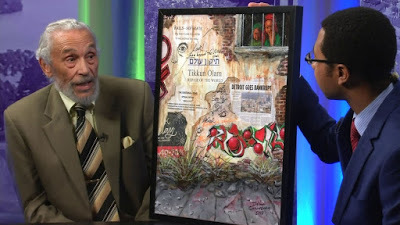 Artist DeVon Cunningham talking about his "docu-art" in 2017
Artist DeVon Cunningham talking about his "docu-art" in 2017Artist DeVon Cunningham hasn't seen the portrait since he painted it. When interviewed by the Detroit News, Cunningham said he spoke to several of Gordy's associates who told him someone put it in Berry's head that it's not a compliment to be shown as Napoleon. After several books came out critical of Gordy and his Motown hit factory, he was concerned with his legacy and may have had the portrait destroyed. If true, Cunningham was deprived of the public exposure and acclaim the National Portrait Gallery listing would have surely brought him.
DeVon Cunningham speaks about his art
Hitsville USA
Published on September 25, 2019 13:46
September 8, 2019
The Fleisher Brothers--Harry and Sam: Crime Doesn't Pay (Part 2 of 2)
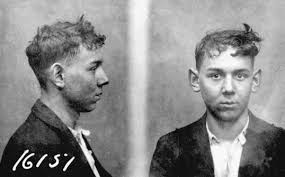 Harry Fleisher 1920 (seventeen years old)
Harry Fleisher 1920 (seventeen years old)Harry Fleisher started his professional criminal career in 1920 as a driver and strong-arm man for the Oakland Sugar House Gang. The leaders of the gang and twelve young thugs were rounded up and charged with extortion in the Cleaners and Dyers War in 1928. The young enforcers put the fear of God into their victims and witnesses against them. Key witnesses recanted their original statements to police or simply disappeared. The Sugar House Gang beat the rap but suffered from the public exposure.
Soon, the leaders of the Sugar House Gang were arrested on a Federal charge of violating the Volstead Act (the Prohibition law) by providing brewing supplies and equipment for the illegal manufacture of beer and whiskey, and for running several industrial-sized stills around the city. The gang disbanded with Charles Leiter and Harry Shorr under federal indictment. What hurt the organization more than anything else was the destruction of their equipment and massive supplies of distilled alcohol.
***
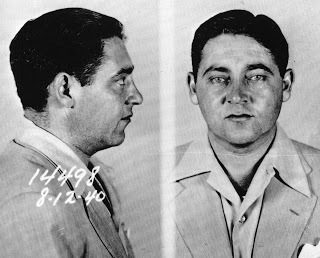 Joe BurnsteinJoe and Ray Burnstein were now free to form a spin-off gang of trusted neighborhood friends and former Sugar House members who soon became known as the Purple Gang. Harry Fleisher was part of the gang's inner circle; his brothers Louis and Sam became foot soldiers. Louis specialized in hijacking and labor racketeering, and Sam was a truck driver and strong-arm man for the organization.
Joe BurnsteinJoe and Ray Burnstein were now free to form a spin-off gang of trusted neighborhood friends and former Sugar House members who soon became known as the Purple Gang. Harry Fleisher was part of the gang's inner circle; his brothers Louis and Sam became foot soldiers. Louis specialized in hijacking and labor racketeering, and Sam was a truck driver and strong-arm man for the organization.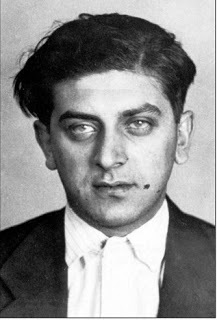 Ray BurnsteinIn a tactical move that threatened the Purple Gang's existence, Ray Burnstein, Harry Keywell, Irving Milberg, and Harry Fleisher laid in wait for several members of the Little Jewish Navy--a group affiliated with the Purples. Izzy Sutker owed Burnstein $1,300 dollars for a liquor purchase he was two weeks late paying back. But there were other issues. Sutker and his boys were interloping Chicago hoods nibbling away at Purple Gang territory by opening several speakeasies on their turf.
Ray BurnsteinIn a tactical move that threatened the Purple Gang's existence, Ray Burnstein, Harry Keywell, Irving Milberg, and Harry Fleisher laid in wait for several members of the Little Jewish Navy--a group affiliated with the Purples. Izzy Sutker owed Burnstein $1,300 dollars for a liquor purchase he was two weeks late paying back. But there were other issues. Sutker and his boys were interloping Chicago hoods nibbling away at Purple Gang territory by opening several speakeasies on their turf.Believing the Burnsteins were phasing out of the liquor business and going legit, Izzy Sutker, Hymie Paul, and Joe Lebowitz showed up at an improvised meeting they thought would make them rich men. Burnstein childhood friend Solomon Levine--and business partner of Izzy Sutker--was duped into driving Sutker and his wing men to the Collingwood Manor Apartments on September 16, 1931 to discuss the deal. But the Purples were harboring another grudge which they could not forgive. One of their men was murdered outside a Purple Gang protected gambling joint on their territory. Word on the street pointed the finger at Sutker as the trigger man.
Levine, Sutker, Paul, and Lebowitz were greeted at the front door of apartment 211 by Ray Burnstein and ushered in to sit on the living room couch. After a brief conversation, Burnstein left the room sayin he had to make a phone call to the gang's business manager from the corner drugstore. Minutes later, Ray was behind the wheel of his Chrysler sedan honking the horn and revving the engine. That was the signal for his boys to stand up and torpedo the Little Jewish Navy where they sat.
The assassins left with Solly Levine in shock. He had no idea he was driving his associates to their deaths. The gunmen scurried down two flights of stairs, burst out the alley door, and jumped into the waiting car. "I let you live, Solly, because you're my friend," Ray told him as he hit the gas pedal and sped off squealing his tires.
Shortly after they fled, Levine was dropped off a few blocks away and given cab fare to return to his sports book (betting parlor). Detroit homicide detectives recognized the victims and knew where they lived. After questioning several residents of the boarding house, they discovered that Solomon Levine had driven off with the Sutker, Paul, and Lebovitz a couple of hours earlier. The police detectives were quick to arrest Levine, who would turn state's evidence. Levine knew he was as good as dead.
Burnstein and Keywell were captured later that evening, and Millberg was caught early the next morning while packing his bags in his apartment. Conspicuous by his absence was Harry Fleisher. He had the good sense to go home, hug his wife goodbye, grab his bug-out bag, and leave town immediately. For this, Fleisher earned the underworld nickname "Slick." After a highly publicized three-week trial, Ray Burnstein, Harry Keywell, and Irving Milberg were convicted and given life sentences at Marquette Prison dealing a staggering blow to the gang.

Fleisher remained at large for nine months. While "on the lam," the Detroit press corps missed no opportunity to drop Harry's name in the newspapers or on radio news broadcasts. Because of his alleged involvement in Detroit's "snatch racket" (kidnapping), Fleisher's name was implicated as a possible suspect in the Lindberg baby kidnapping. The FBI charge gave Harry national exposure as his face and description appeared on wanted posters hung in every police station and post office in the nation. Fleisher was being hunted coast-to-coast.
On June 9, 1932, Harry Fleisher surprised Detroit Prosecutor Harry S. Toy by showing up with his lawyer at the prosecutor's fifth-floor office in Detroit Police Headquarters. Fleisher was arrested and held without bond. Despite the prosecutor's best efforts to try Fleisher, Toy's star witness who could link Harry to the Collingwood Massacre was unable to be found. The case against Fleisher was dismissed. Twenty years later, missing witness Sol Levine reappeared in Detroit. Levine told a Detroit Free Press staff reporter that he had shipped out with the merchant marine to make himself scarce. "I made $135 a month--the first honest money I ever made. It felt good."
***
Harry Fleisher's arrest file was one of the thickest in the history of the Detroit Police Department coming in at 204 pages. He was arrested thirty times for charges ranging from receiving stolen property, grand larceny, violating the prohibition law, armed robbery, assault with intent to kill, kidnapping, possession of an unregistered gun, suspicion of murder, and a traffic violation. Convicted four times but serving no jail time, Fleisher paid fines totaling $715--chump change for him. What he paid in lawyer fees was much higher to be sure.
Despite Prohibition ending on December 5, 1933, there was still money to be made in trafficking illegal alcohol. Now that the state and federal governments were in the liquor business, the cost of legal booze with a federal tax stamp was costly. Harry and his youngest brother Sam were operators of a 4,000 gallon unregistered distillery that took up three stories of a warehouse building at 5620 Federal Avenue.
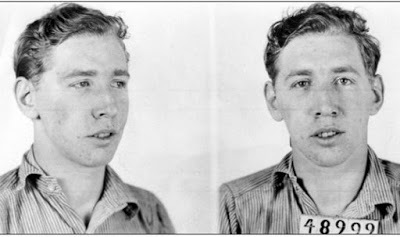 Sam Fleicher 1935 (twenty-four years old)While under FBI surveillance, Sam drove a semi-truck loaded with 10,500 pounds of brown sugar purchased from a wholesaler in Cleveland, Ohio to the Guardian Transit Company warehouse at Sixteenth and Pine Streets in Detroit. The brown sugar was loaded into smaller vans and transported to the Fleisher brothers' distillery. On April 11, 1935, a Federal alcohol tax unit raided the operation and arrested former Purple Gang members Sam Fleisher, Jack Selbin, and Joe Stein. Once again, Harry managed to escape before he was arrested.
Sam Fleicher 1935 (twenty-four years old)While under FBI surveillance, Sam drove a semi-truck loaded with 10,500 pounds of brown sugar purchased from a wholesaler in Cleveland, Ohio to the Guardian Transit Company warehouse at Sixteenth and Pine Streets in Detroit. The brown sugar was loaded into smaller vans and transported to the Fleisher brothers' distillery. On April 11, 1935, a Federal alcohol tax unit raided the operation and arrested former Purple Gang members Sam Fleisher, Jack Selbin, and Joe Stein. Once again, Harry managed to escape before he was arrested.Harry Fleisher was named in the original warrant but remained at large until he surrendered himself to Federal authorities on October 29, 1935 when he was indicted, placed under a $2,500 bond, and held over for trial with the other men. All four men were convicted on April 11, 1936 of conspiracy to violate the Internal Revenue Service Act, given eight-year prison sentences and fined $20,000 each. Additionally, the Fleisher brothers had a federal tax lien of $14,028 levied against them for unpaid taxes on 2,275 gallons of alcohol.
The convicted men were transitioned into the federal penitentiary system in Leavenworth, Kansas. After a month of quarantine, they were taken by train to San Francisco, and from there were ferried across the bay to Alcatraz Island where they served four and a half years of their eight-year sentence. They were released early for good behavior. Again, the men were transitioned to Leavenworth before being released on June 28, 1940. In 1941, Harry Fleisher opened a florist shop on Twelfth Street. Sam went to work at his father's junkyard in Jackson, Michigan after his release.
***
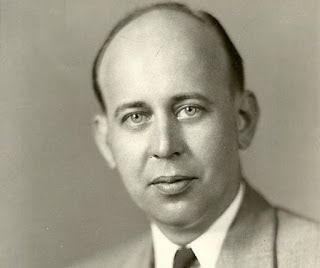 Michigan State Senator Warren G. HooperHarry and Sam were habitual criminals determined to lead a life of crime. On January 11, 1945, State Senator Warren G. Hooper--while en route to his home in Adrian, Michigan--was shot three times in the head at close range and found next to his burning car on U.S. Highway 99 near Springport in Jackson County. Passing drivers told state police they saw a maroon car blocking Hooper's sedan on the wrong side of the highway. Hooper was slated to be a key witness against Frank D. McKay--former Republican National Committeeman--in a state government race track bribery case.
Michigan State Senator Warren G. HooperHarry and Sam were habitual criminals determined to lead a life of crime. On January 11, 1945, State Senator Warren G. Hooper--while en route to his home in Adrian, Michigan--was shot three times in the head at close range and found next to his burning car on U.S. Highway 99 near Springport in Jackson County. Passing drivers told state police they saw a maroon car blocking Hooper's sedan on the wrong side of the highway. Hooper was slated to be a key witness against Frank D. McKay--former Republican National Committeeman--in a state government race track bribery case.Chief of the Michigan State Police Detective Harold Mulbar told the press that Senator Hooper had refused police protection. "The Hooper murder was definitely a paid gangster killing," Mulbar said. An intensive search for the killers kicked up several ex-cons who pointed the finger at four men who tried to hire them to assassinate the state senator. Fearing they would violate their paroles and be sent back to prison, the ex-cons turned state's evidence. The corroborated testimony of Henry Luks, Al Kurner, and Sam Abramowitz led to the convictions of Harry Fleisher, Sam Fleisher, Myron "Mikey" Selik, and Pete Mahoney for conspiracy to commit murder.
The conspiracy was hatched at O'Larry's Bar located at Boston and Dexter Streets in Detroit. First, Henry Luks was asked if he knew how to wire dynamite to a car's ignition. Luks said he did. Several days later, he reconsidered and said he didn't have access to dynamite and refused the $3,000 job. Alfred Kurner was then asked and offered the same amount, but he also refused citing problems with the parole board. Then, Sam Abramowitz agreed, but after making several trips to Adrian in preparation for the hit, he dropped out of the plot when he saw Hopper at home with his wife and kids. Abramowitz didn't have the stomach for it. He returned to Flint, Michigan where he had worked as a barber since his parole from Jackson Prison in 1943.
On July 31, 1945--after a grand jury trial lasting two weeks, a jury of five women and seven men reached a guilty verdict after only two hours of deliberation. The grand jury was unable to determine who shot Hooper or who financed the $15,000 fund to murder him. The defendants were sentenced to serve four and one-half years in Jackson Prison. Pending an appeal to the Michigan Supreme Court for a new trial, the men were released on $25,000 bonds on July 10, 1946. When their appeal was denied, Harry Fleisher and Mikey Selik jumped bail.

Fleisher dodged arrest for fifteen months. Acting on a phone tip, he was seized by FBI agents in Pompano Beach, Florida--thirty-five miles north of Miami. He and a woman companion Bernice Jackson were registered at a tourist court as Mr. and Mrs. Marvin Goldwyn of Toledo, Ohio. The couple left the cottage and drove to the beach in Fleisher's pickup truck. A squad of four agents dressed in sports shirts and slacks slowly closed in on the couple sunning themselves on the beach. When the agents were noticed fifteen feet away, they rushed on Fleisher and held his face down in the sand while they handcuffed him. Miss Jackson stood quietly with her hands up in the air. When their cottage was searched, a submachine gun was found with 400 rounds of Colt ammunition. Fleisher had $1,200 cash in his possession. He was arrested on a Federal fugitive warrant, and Miss Jackson was jailed as a material witness.
 Fleisher was extradited to Michigan arriving at Willow Run Airport aboard a Capital Airlines plane in the custody of two U.S. Marshalls and a Federal guard. He was whisked away to Milan Federal Prison on January 22, 1950. Two days later, the beleaguered fugitive confessed to Detroit Free Press reporter Ralph Nelson that "I'm glad it's over. It hasn't been fun being hunted. I'm looking forward to seeing my wife Harriet. I expect to have a rough time with her. She knows about the other woman, but Hattie knows that a man travels practically unnoticed when he travels with a woman. She'll understand that. I've always tried to keep Hattie from being involved in any of my troubles."
Fleisher was extradited to Michigan arriving at Willow Run Airport aboard a Capital Airlines plane in the custody of two U.S. Marshalls and a Federal guard. He was whisked away to Milan Federal Prison on January 22, 1950. Two days later, the beleaguered fugitive confessed to Detroit Free Press reporter Ralph Nelson that "I'm glad it's over. It hasn't been fun being hunted. I'm looking forward to seeing my wife Harriet. I expect to have a rough time with her. She knows about the other woman, but Hattie knows that a man travels practically unnoticed when he travels with a woman. She'll understand that. I've always tried to keep Hattie from being involved in any of my troubles."Fleisher pleaded guilty on the Federal fugitive charge on February 1, 1950. On February 24, 1950, Bernice Jackson--a former Detroit prostitute--was sentenced to five months in the Miami City Jail for harboring an escaped criminal.
After Fleisher served his five-year sentence in Milan Prison as a Federal fugitive, he was shuttled back to Jackson State Prison to serve his five-year sentence for conspiracy to murder Senator Hooper. Because of a conviction for the armed robbery of the Aristocratic Club in Pontiac, Michigan in 1945, Fleisher had an additional 25 to 50 years to serve. Once again, Slick jumped bail while out on appeal.When Harry was released from Jackson Prison in the mid-sixties, he took a legitimate job as a warehouse manager for Ewald Steel Company.
Harry Fleisher died in 1978 at the age of seventy-five. He was preceded by Louis, who died in Jackson Prison on April 3, 1964 at the age of fifty-nine and Sam, who died on January 18, 1960 in Miami, Florida at the age of forty-nine. All three brothers succumbed to heart failure.
The Fleisher Brothers (Part 1)
Published on September 08, 2019 04:05
September 1, 2019
The Fleisher Brothers--Louis: Unlucky or Stupid? (Part 1 of 2)
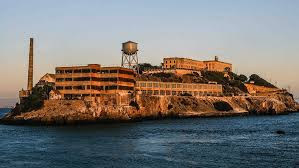 Alcatraz--the Rock.
Alcatraz--the Rock.Despite Abe Burnstein disbanding the Purple Gang in 1935, former members Harry and Louis Fleisher were indirectly responsible for keeping the defunct gang's name in the local press from the late 1930s through Harry's death in 1978. Those boys couldn't stay out of trouble. Every time their names appeared in the press--and there are hundreds of citations--the tags "former Purple Gang members," "alleged Purple Gang members," or "Purple Gang leaders" preceded their names.The Fleisher brothers may hold the record for the most family members to do hard time on the Rock--Alcatraz Federal Penitentiary off the coast of San Francisco.
Harry, Louis, and Sammy grew up in the same Paradise Valley neighborhood as the Burnstein brothers and other tough street kids who eventually coalesced into the Purple Gang. They learned their street smarts by preying on handcart operators at the Eastern Market and harassing shop owners on Hastings Street with petty crime and vandalism.
Harry Fleisher began his underworld career as a driver and bodyguard for Oakland Sugar House Gang leader Charles Leiter in the 1920. Harry was a trigger man and shakedown artist of legal and illegal businesses like speakeasies and disorderly houses (brothels). For unknown reasons, Harry interacted as little as possible with younger brother Louis.
Louis began his professional crime career as a trigger man, a labor "organizer," and a hijacker for the Sugar House Gang. When the Sugar House Gang suffered a devastating bust of their leadership in the late 1920s, Louis gravitated to the Purple Gang.
When Louis was only twenty-two years old, he was the first of the three Fleisher brothers to serve hard time. Lou Jr.'s day job was helping his father Lou Sr. run an auto junkyard. Their side-job was retrofitting touring cars with hidden compartments for smuggling illegal liquor or concealing guns.
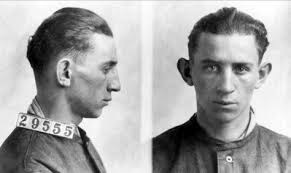 Louis Fleisher mug shot--1927. In 1927, Louis and three other men hijacked a semi-truck in Flat Rock, Michigan, loaded with 400 new automobile tires bound for Akron, Ohio. A green Studebaker sedan swept in front of the semi blocking it at a stop sign. Four men jumped out of the car with shotguns and machine guns commanding the drivers to get out of the truck. They were bound and shoved into the back seat of the Studebaker.
Louis Fleisher mug shot--1927. In 1927, Louis and three other men hijacked a semi-truck in Flat Rock, Michigan, loaded with 400 new automobile tires bound for Akron, Ohio. A green Studebaker sedan swept in front of the semi blocking it at a stop sign. Four men jumped out of the car with shotguns and machine guns commanding the drivers to get out of the truck. They were bound and shoved into the back seat of the Studebaker.Two of the hijackers took the truck and the other two drove off with their captives. The bound men noticed there was some chrome trim damage on the passenger side of the car. One of them took the added precaution of spitting on the rear window to mark the car as the one they were abducted in. The truck drivers were released unharmed twelve hours later. The empty semi-truck was found two days later, and the green Studebaker with the faulty trim was tracked down shortly after that. The car's serial number revealed the owner to be Louis Fleisher.
Louis was located and arrested, but he refused to identify the other hijackers he was working with. After an initial plea of "not guilty," Louis changed his plea to "guilty," reasoning that he was safer in prison than on Detroit's streets. If he took the rap and served his time, he would prove himself to be a stand up guy and survive. If he was released on bail, he would be considered a risk to the gang and sooner than later he would be found dead on a city street someplace. A federal judge sentenced Louis to ten years at Leavenworth Federal Penitentiary. He served a minimum sentence of six years and three months before being paroled for good behavior.
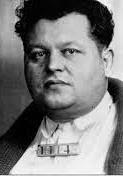 Sam BurnsteinNine months after being paroled, Louis went into business with former Purple Gang speakeasy operator Sam "Fatty" Burnstein--not blood-related to the Burnstein brothers--reputed leaders of the Purples. Sam and Louis were brothers-in-law; Sam's sister Nellie was Louis's wife. Fleisher and Burnstein opened a scrap metal and auto junkyard in the autumn of 1935 far from Detroit in Albion, Michigan. The business was named Riverside Iron and Metal Company. Both men needed to demonstrate to their parole boards that they had gone "straight" and had a steady source of income.
Sam BurnsteinNine months after being paroled, Louis went into business with former Purple Gang speakeasy operator Sam "Fatty" Burnstein--not blood-related to the Burnstein brothers--reputed leaders of the Purples. Sam and Louis were brothers-in-law; Sam's sister Nellie was Louis's wife. Fleisher and Burnstein opened a scrap metal and auto junkyard in the autumn of 1935 far from Detroit in Albion, Michigan. The business was named Riverside Iron and Metal Company. Both men needed to demonstrate to their parole boards that they had gone "straight" and had a steady source of income.These guys must have loved crime because their junkyard was a front for a safe cracking operation in central Michigan. The parolees went into a partnership with the Lizard Gang--a Hamtramck burglary ring. A nine-month crime spree ensued.
Louis used his mechanical, fabrication, and body shop skills to convert a 1935 Graham Paige sedan into a rolling fortress.The Graham Paige was stolen from a Dodge dealership in Ferndale, Michigan. This particular car was desirable because it was wider than other makes and was equipped with an eight-cylinder Blue Streak supercharged engine that could reach speeds of 100 mph. The car was bulletproofed, the passenger side doors were retrofitted to open extra wide, and a ramp was welded to the undercarriage which rolled out to load stolen safes quickly.

The Michigan State Police were baffled. Fifty businesses had been burglarized over a vast section of central Lower Michigan. Robberies occurred in Battle Creek, Grand Rapids, Lansing, Jackson, and Ionia. The burglary team stole safes from businesses and either blew their doors off with nitroglycerin or took the safes to the junkyard and burned off the combination locks with an acetylene torch.
On May 11, 1936 at 2:30 a.m., night clerk Jack Kane at the Capital Hotel next door to the Isabell Seed Company in Jackson, Michigan, heard men struggling to load the company's 500 pound safe through the side doors of the Graham Paige sedan. The burglary was reported to the State Police, but troopers were too slow on the scene to make an arrest or give chase. Then on May 30th, a local Albion resident reported to state police that a suspicious Graham Paige sedan was being stored in a barn across from the junkyard in Albion.
Officers from the Michigan State Police and the Adrian Police Department descended upon the barn, broke in, and found the car with its left side strafed with bullets. The police also discovered two sets of stolen license plates, weapons, and burglary tools. Nitroglycerin, blasting caps, and fifteen feet of wire were concealed in the side panels of the car. State Police quickly arrested Fleisher and Burnstein along with their wives. Two junkyard employees were also brought in for questioning but later released for lack of evidence. After a brief investigation, Louis and Sam were indicted and posted bonds of $5,000 apiece. While awaiting trial, Louis jumped bail and remained at large for a year.
On the night of April 8, 1938, Louis Fleisher's car was pulled over by the Highland Park police. His wife Nellie tossed a .38 calibre automatic pistol out the passenger window which police soon found. A clumsy attempt had been made to etch out the gun's serial number. Louis and Nellie were arrested with a twenty-two-year-old man who gave his name as Jack Sherwood but was soon found to be Sid Markham--a first-degree murder fugitive from Brooklyn, New York. Markham was extradited to New York where he was convicted and sent to the electric chair in Sing Sing Correctional Facility on January 18, 1940.
 Samples of weapons found in Fleisher apartment.Louis and Nellie's arrests led to a search of their Highland Park apartment where police found what they described to reporters as "the largest underworld arsenal ever found in the Midwest." The unregistered arsenal was neatly packed in a trunk containing submachine guns, automatic pistols, revolvers with silencers, brass knuckles, tear gas shells, and thousands of rounds of ammunition.
Samples of weapons found in Fleisher apartment.Louis and Nellie's arrests led to a search of their Highland Park apartment where police found what they described to reporters as "the largest underworld arsenal ever found in the Midwest." The unregistered arsenal was neatly packed in a trunk containing submachine guns, automatic pistols, revolvers with silencers, brass knuckles, tear gas shells, and thousands of rounds of ammunition.The Fleishers were held in Milan Detention Farm under a $50,000 bond each. On April 7, 1939, Louis Fleisher was sentenced to thirty years in Alcatraz Federal Penitentiary; Nellie received ten years in a Federal detention home. After serving nineteen years of his original sentence, Louis was released for good behavior from Alcatraz at the age of forty-one.
As a moth is drawn to a flame, so was Louis drawn to crime. On midnight Sunday, October 26, 1958, Fleisher and partner in crime Joe Anielak were caught red-handed trying to torch Dorsey's Cleaners on East Seven Mile Road. Anielak climbed on the roof with a length of rope. He threw one end down to Fleisher who attached a five-gallon gas can to the rope and Anielak pulled it up. They did this twice.
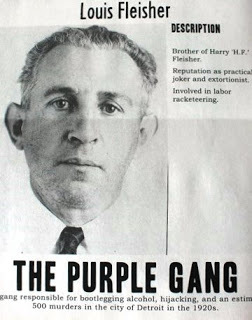 Little did the pair know they were under police surveillance on the ground and hidden on the roof tops of adjoining buildings. Anielak drilled several holes in the roof with a brace and bit auger. He inserted a funnel and was about to pour gas through the hole when police scout cars turned their floodlights on the roof. Anielak tried to flee, but when a detective fired a warning shot at him he surrendered. Fleisher was arrested in the alley. Because Fleisher had broken the terms of his parole, he was sent to Leavenworth Penitentiary to serve out the rest of his original thirty-year Federal sentence while awaiting trial on the Michigan charges.
Little did the pair know they were under police surveillance on the ground and hidden on the roof tops of adjoining buildings. Anielak drilled several holes in the roof with a brace and bit auger. He inserted a funnel and was about to pour gas through the hole when police scout cars turned their floodlights on the roof. Anielak tried to flee, but when a detective fired a warning shot at him he surrendered. Fleisher was arrested in the alley. Because Fleisher had broken the terms of his parole, he was sent to Leavenworth Penitentiary to serve out the rest of his original thirty-year Federal sentence while awaiting trial on the Michigan charges. The two men were charged with three counts: conspiracy to place explosives, breaking and entering, and intent to destroy property with explosives. Each of the counts carried a fifteen-year sentence. Detroit defense lawyers Joseph Louisell and Ivan Barris delayed proceedings for two years until they plea bargained for an attempted arson charge which carried a maximum five-year jail term. It was unlikely that a jury would convict the defendants on the original charges because no explosives were found at the crime scene. The prosecutor didn't want these men acquitted. On October 17, 1960, the men pleaded guilty to the lesser charge of attempted arson and were given a three to five year sentence.
Louis Fleisher was transferred from Leavenworth to Milan Federal Prison to serve out his sentence. On April 3, 1964, he died of a heart attack in his jail cell just nine weeks and two days short of serving out his Detroit conviction for arson and leaving prison a free man. He was fifty-nine-years-old.
***
Louis's older brother Harry and his younger brother Sam also had checkered underworld careers which will be the subject of part two of this post.
Published on September 01, 2019 08:23
August 24, 2019
Early Detroit Tiger History
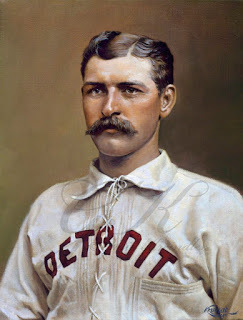 Charlie BennettPrior to 1894, the Detroit Tigers played minor league baseball and were one of the founding members of the West League that played throughout the Great Lakes states. Owner George Vandereck choose the corner of Michigan and Trumbull Boulevards as their home field. Previously, the vacant lot was used as a local hay market for farmers and livestock owners. Vandereck bought the lot and built Bennett Park--named after a popular Tiger catcher Charlie Bennett--who lost his legs in a railway accident in 1894 while walking on a rain-slick train platform and falling onto the tracks. As the train pulled out, Bennett's left foot and his right leg above the knee were severed, ending his baseball career.
Charlie BennettPrior to 1894, the Detroit Tigers played minor league baseball and were one of the founding members of the West League that played throughout the Great Lakes states. Owner George Vandereck choose the corner of Michigan and Trumbull Boulevards as their home field. Previously, the vacant lot was used as a local hay market for farmers and livestock owners. Vandereck bought the lot and built Bennett Park--named after a popular Tiger catcher Charlie Bennett--who lost his legs in a railway accident in 1894 while walking on a rain-slick train platform and falling onto the tracks. As the train pulled out, Bennett's left foot and his right leg above the knee were severed, ending his baseball career.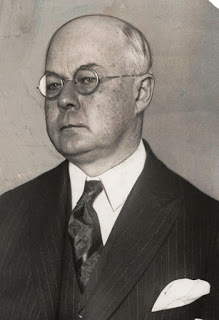 Frank "Old Stone Face" NavinIn 1901, the Tigers joined the new American League as one of its eight founding members. Samuel F. Angus bought the Tigers in 1902 and hired lawyer and baseball enthusiast Frank Joseph Navin to run the club for him. As a young man, Navin was a blackjack and poker dealer in an illegal gambling establishment. He loved horse racing and was an avid wagerer at two racetracks in Windsor, Ontario and attended the Kentucky Derby annually. In 1908, Navin parlayed $5,000 of winnings into buying a significant portion of Tiger stock.
Frank "Old Stone Face" NavinIn 1901, the Tigers joined the new American League as one of its eight founding members. Samuel F. Angus bought the Tigers in 1902 and hired lawyer and baseball enthusiast Frank Joseph Navin to run the club for him. As a young man, Navin was a blackjack and poker dealer in an illegal gambling establishment. He loved horse racing and was an avid wagerer at two racetracks in Windsor, Ontario and attended the Kentucky Derby annually. In 1908, Navin parlayed $5,000 of winnings into buying a significant portion of Tiger stock.In 1908, Navin bought another large block of shares making him controlling owner and new president of the organization. When Navin's silent business partner William Yawkey--lumber fortune heir--died in 1919, Navin bought his stock becoming full owner of the club. Because he was suddenly cash-poor, he sold 25% of the franchise to auto-body manufacturer Walter Briggs Sr. and 25% to wheel maker John Kelsey of Kelsey-Hayes Corporation. When Kelsey died, Briggs bought his interest in the team becoming an equal co-owner with Navin, but Briggs was content to allow Navin to run the team unhampered.
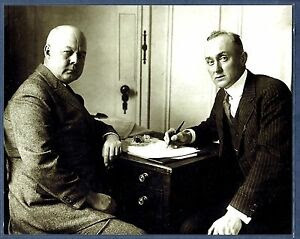 Frank Navin and Ty CobbIn 1905, Navin signed legendary Tiger center fielder Ty Cobb for $1,500. The talented ballplayer led the Tigers to their first American League pennant win in 1907. Between seasons, Cobb held out for a $5,000 contract. After bitter negotiations, Navin--a tight-fisted owner--met his match. Cobb was wildly popular with the fans and threatened to expose Navin for the conniving cheapskate he was. The penny-pinching owner quickly did the math and caved-in to Cobb's demand. Cobb led the Tigers to two more consecutive American League pennants in 1908 and 1909 turning a nice profit for the team. Navin made Cobb the team's manager as well as him being the team's star player.
Frank Navin and Ty CobbIn 1905, Navin signed legendary Tiger center fielder Ty Cobb for $1,500. The talented ballplayer led the Tigers to their first American League pennant win in 1907. Between seasons, Cobb held out for a $5,000 contract. After bitter negotiations, Navin--a tight-fisted owner--met his match. Cobb was wildly popular with the fans and threatened to expose Navin for the conniving cheapskate he was. The penny-pinching owner quickly did the math and caved-in to Cobb's demand. Cobb led the Tigers to two more consecutive American League pennants in 1908 and 1909 turning a nice profit for the team. Navin made Cobb the team's manager as well as him being the team's star player. Bennett ParkBennett Park consisted of a wooden grandstand and bleachers. It was the smallest ballpark in the league seating 14,000. Owners Navin and Briggs tore down the obsolete wooden Bennett Park between the 1911 and 1912 seasons and built a concrete and steel stadium seating 23,000 fans--renaming it Navin Field. In 1924, Navin built a second deck increasing seating to 30,000.
Bennett ParkBennett Park consisted of a wooden grandstand and bleachers. It was the smallest ballpark in the league seating 14,000. Owners Navin and Briggs tore down the obsolete wooden Bennett Park between the 1911 and 1912 seasons and built a concrete and steel stadium seating 23,000 fans--renaming it Navin Field. In 1924, Navin built a second deck increasing seating to 30,000.By 1931, the Great Depression cut Tiger attendance by 30%. To draw fans to the ballpark, Navin tried to sign the most popular player in the game--Babe Ruth--but he wasn't availabe, so Navin bought out Mickey Cochrane's contact from Philadelphia Athletics manager Connie Mack for $100,000 and made him a player-manager. Cochrane was just what the team needed. He helped the Tigers win pennants in 1934 and 1935.
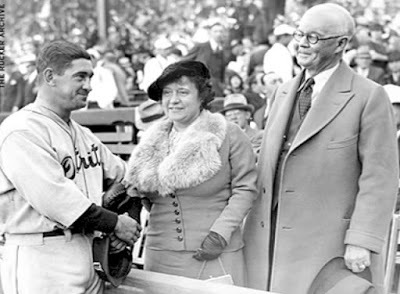 Mickey Cochran with Grace and Frank Navin--1935Under Navin's stewardship, the Tigers won four American League pennants but did not win a World Series until the 1935 season, giving the Tigers their first series win. But Navin's victory lap was short-lived. Navin and his wife Grace rode horses several times a week at the Detroit Riding and Hunt Club. Six weeks after the Tigers won the series, Navin went for a solo ride on his favorite horse Masquerader and suffered a fatal heart attack, falling to the ground. When his horse returned riderless to the stable, his wife cried out for help, but it was too late. Navin was dead at age sixty-five. He was buried in Holy Sepulchre Cemetery in Southfield, Michigan in a family mausoleum.
Mickey Cochran with Grace and Frank Navin--1935Under Navin's stewardship, the Tigers won four American League pennants but did not win a World Series until the 1935 season, giving the Tigers their first series win. But Navin's victory lap was short-lived. Navin and his wife Grace rode horses several times a week at the Detroit Riding and Hunt Club. Six weeks after the Tigers won the series, Navin went for a solo ride on his favorite horse Masquerader and suffered a fatal heart attack, falling to the ground. When his horse returned riderless to the stable, his wife cried out for help, but it was too late. Navin was dead at age sixty-five. He was buried in Holy Sepulchre Cemetery in Southfield, Michigan in a family mausoleum.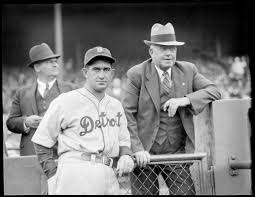 Mickey Cochrane and Walter BriggsAfter Navin's death, Walter O. Briggs purchased Navin's stock and became sole owner. Because Briggs made a fortune manufacturing automobile bodies for Ford, Chrysler, Packard, Hudson, and Willys-Overland, he did not need an income from the team and promised not to take a salary during his tenure as owner. In 1938, he changed the name of Navin Field to Briggs Stadium and remained the sole owner of the Tigers until his death in 1952. The stadium was renamed Tiger Stadium in 1961 until the franchise moved to Comerica Park in 2000.
Mickey Cochrane and Walter BriggsAfter Navin's death, Walter O. Briggs purchased Navin's stock and became sole owner. Because Briggs made a fortune manufacturing automobile bodies for Ford, Chrysler, Packard, Hudson, and Willys-Overland, he did not need an income from the team and promised not to take a salary during his tenure as owner. In 1938, he changed the name of Navin Field to Briggs Stadium and remained the sole owner of the Tigers until his death in 1952. The stadium was renamed Tiger Stadium in 1961 until the franchise moved to Comerica Park in 2000.For 104 seasons, the Tigers played baseball at Michigan and Trumbull earning them the distinction of being the oldest continuous one name-one city franchise in major league baseball.
1935--Detroit Tigers, Lions, and Red Wings win their championships.
Published on August 24, 2019 07:43



